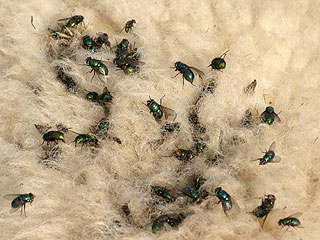Fly-strike
 My regular 6-monthly meeting with Martyn Lane, the BBOWT Oxfordshire Reserves Officer, was called short when he noticed that a few of the flock of 29 sheep had ‘fly strike’. The flock had only come on a month ago and were busily muching their way through the grass in compartment 1.
My regular 6-monthly meeting with Martyn Lane, the BBOWT Oxfordshire Reserves Officer, was called short when he noticed that a few of the flock of 29 sheep had ‘fly strike’. The flock had only come on a month ago and were busily muching their way through the grass in compartment 1.
Fly strike is a farming term for when blowfly larvae burrow into the skin of livestock, causing intense irritation and open wounds that can get infected. These secondary infections can cause blood poisoning if the problem isn’t spotted quickly.
Livestock are usually treated with strong insecticides at the beginning of the year but by autumn the chemicals have worn off and warm, damp weather can bring on a fly-strike attack. Blowflies are attracted to the damp wool and lay their eggs next to the skin in places along the back where the sheep cannot reach.
It is usually very easy to spot because the sick sheep will appear listless and reluctant to move. Others often run about and try to bite their backs – or hide under bushes, trying to scratch etc. A closer examination would show clouds of green-bottle blowflies around patches of matted wool. A fly-strike attack can come on very fast and in our flock they were inspected a few days previously and they were behaving normally. Blowfly eggs hatch within 24 hours and larvae grow very fast so any flock needs checking very regularly.
Treatment is by cutting away the wool and removing the fly’s eggs and maggots by hand. Open wounds are treated with antiseptics and the whole flock is usually sprayed with an insecticide. In our case only 6-7 had actually been attacked so we must have caught it early. As well as the usual treatment we moved the whole flock to a higher compartment with better ventilation where we hope the flies won’t be such a problem.

Hello Hartslock,
I am currently co-editing a book on the dipteran family, Calliphoridae and would like permission to use the above photo in my first chapter. Might I gain permission to use it and of course, I would cite this page or the photographer.
Thanks for your help,
cheers, john
Absolutely John – no problem